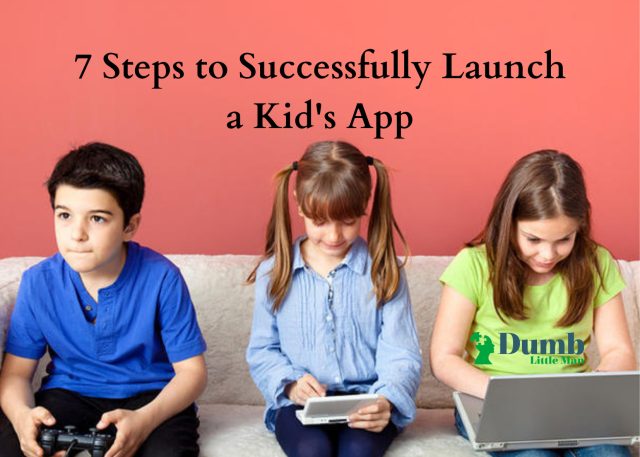7 Steps to Successfully Launch a Kid’s App
By Jean Hartley
January 10, 2024 • Fact checked by Dumb Little Man

According to experts, parents have become more interested in children's educational applications with games, cartoons, lessons on creativity.
However, of a large number of applications available for download – there are about 15 thousand of them in the Amazon App Store alone – only a part is popular. Let's figure out what influences the success of the app for children and how to launch it correctly.
Step 1: Decide on the type of app

For those who really want to create a children's product but have not yet found a niche. Children's apps, in general, are divided into:
• gaming, completely aimed at the entertainment of the user. For example, Among us. To create such an application, a fascinating scenario and game mechanics are first of all important, which will keep the child's attention;
• educational, usually gamified. Most often designed for preschoolers. For such an application to be successful, it must have clear educational value; apps for creativity.
• applications for creativity. Apps that allow you to draw, paint pictures, build something. An example is Kids Doodle. The more features your application has and the easier it is to use, the more popular it will become.
Step 2: Select target audience
Maybe this point seems obvious to you, but don't jump to conclusions. With children's apps, it is not so simple. For example, if your product is designed for preschoolers, you have two audiences: a child and a parent. You find yourself in a unique situation where the customer and the user are different people. And in this case, when creating an app, you have to take into account the interests of both.
But it is not enough to single out two target audiences. The audience of children needs to be segmented by age because the content in the app will depend on what the child knows and likes. You can't create a universal app for two- and seven-year-olds, because some are just learning colors and others can already solve the simplest arithmetic examples.
Depending on the chosen target audience, you will form the communication and marketing strategy to promote the product.
Step 3: Choose a monetization strategy
There are several ways to make money on a children's app. The monetization model, of course, is better to choose as soon as you have a product idea. The main types are:
• Paid app. The user buys the app with all the content inside once.
• Free-to-play. Free app with in-app purchases (often practiced in games like Roblox) or paid advanced features. A 2020 SellCell survey found that kids are increasingly spending money on mobile games. 8.2% of parents in the United States indicated that the amount was more than $ 100 per month. However, many parents dislike this trend.
• Subscription model. The most popular and fastest-growing income category in this area. The user buys the application by subscription: weekly, yearly, or monthly – the content is regularly updated (which allows keeping interested in the product).
• Ads for other products inside the app. There are pitfalls here. Due to the ban on identifying IDs and tracking other information about users in children's applications, advertising will be non-targeted, and therefore less effective. From which it follows that the cost of advertising will decrease, which means that the payments to you as an application developer will also decrease. Another disadvantage is that the child will constantly click on pop-up banners leading to third-party sites, which can provoke uncontrolled purchases. And this may not please the parents.
Step 4: Conduct life tests
It's necessary to test the app on children as soon as you have the first working version of the product. The point is that adults think differently. On tests, you are likely to find flaws in the interface (too small buttons, for example) or sagging places in the gameplay.
You may also find that you have placed the interactive elements incorrectly (the child will unsuccessfully click on static objects, or, conversely, ignore those that need to pay attention).
Only after life-tests and subsequent improvements can be considered that you have a ready-made application.
Step 5: Ask Parents

Your app can be as fun as you want, but if it doesn't meet the parent's needs, you won't get a lot of installs. Needs can range from getting your child ready to the need to acquaint the child with notes or even teach how to handle the first pocket money. It's especially important to do a CustDev if you're developing an app for preschoolers since your customer in this case is the parent. And the sooner you do it, the better.
Step 6: Design the interface and graphics
The interface in a children's app should be simple, intuitive, but at the same time bright and memorable. Add interactive elements to make it more interesting for a child.
In order to highlight them, you have techniques such as shadow effects, colored outlines, darkening the background, and animations at your disposal. If your users are preschoolers, don't forget that most of them can't read. So you'll need to use voice-over and sound effects.
The main thing is to take care of a consistent visual style that allows you to quickly produce content for the app. Especially if you work on a subscription model and constantly supplement the product with new levels and games.
Step 7. Start on time
The problem with many aspiring developers is that they tend to perfect the app before launching it. Firstly, this is not possible, because, in the end, you will most likely have to fix bugs anyway that could not have been detected before full use of the product.
Secondly, there is absolutely no need. The app can be flawed and still popular because kids aren't as meticulous as adults.
However, these bugs have no effect on the promotion of the product and on getting pretty good monetization metrics at the start.
Jean Hartley
Jean Hartley is a professional content writer for "write my paper" service. She will help you to prepare an overview, report, essay, or another paper. Jean will make you amazed with the final interesting content or any other you may have for writing.


